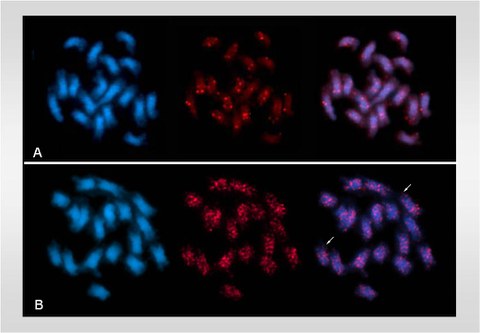Long Interspersed Nuclear Elements (LINEs)
Long interspersed nuclear elements (LINEs) are a major part of the mobile DNA fraction of the genome. They often multiply, and thus can colonize large genomic fractions. Although highly abundant and thoroughly investigated in mammals, LINEs have been barely in the focus of plant research. Only a few LINE-families are characterized in plants and only two are proven active. This lack of knowledge leads to LINE underestimation and ambiguous annotation plant genome projects. In a comprehensive survey of 59,390 LINE sequences from 23 plant genomes we measured LINE diversity, in order to deduce a LINE classification system for a simplified annotation of highly divergent plant LINEs.

Relationship of plant LINE reverse transcriptases. (a) A weighted dendrogram has been constructed from 2640 RT amino acid sequences originating from 275 plant and 16 animal LINE families. The RTs sequences form seven plant L1 subclades and a single plant RTE cluster marked by brackets. (b) The tree branches of (a) are color-coded according to the relationships of the analyzed species.
In Beta vulgaris (sugar beet), we characterized the complete LINE population (Belline elements). LINEs of the Belline6/BvL family are highly repetitive in the B. vulgaris genome. Interestingly, their truncation rate is increasing towards the 3’ end, hence, only a few members are of full length. This is an illustrative example of the limitations of the Target Primed Reverse Transcription integration mechanism: Often, the reverse transcriptase releases the mRNA before the reverse transcription is completed, thereby generating 5’-truncated copies.
A striking feature of the middle repetitive Belline1/BNR-elements is the absence of the typical CCHC-type zinc finger in the ORF1, which is needed for binding and transport of the LINE-RNA to its target sequence. However, its function may be substituted by another type of RNA binding structure, the RNA recognition motif. We identified LINEs with a similar ORF1 structure in several other plant species like poplar, soybean or lotus. Therefore, we consider BNR as an example of a novel LINE BNR subclade.
BvL- as well as BNR-type LINEs have a clustered localization on chromosomes. They are present on the majority of chromosomes.
Related publications
- Heitkam et al. (2014): Profiling of extensively diversified plant LINEs reveals distinct plant-specific subclades. The Plant Journal 79:385-397, read article
- Wenke et al. (2009): An abundant and heavily truncated non-LTR retrotransposon (LINE) family in Beta vulgaris. Plant Molecular Biology 71:585-597. read article
- Heitkam and Schmidt (2009): BNR – a LINE family from Beta vulgaris – contains a RRM domain in open reading frame 1 and defines a L1 sub-clade present in diverse plant genomes. The Plant Journal 59:872-882 read article

